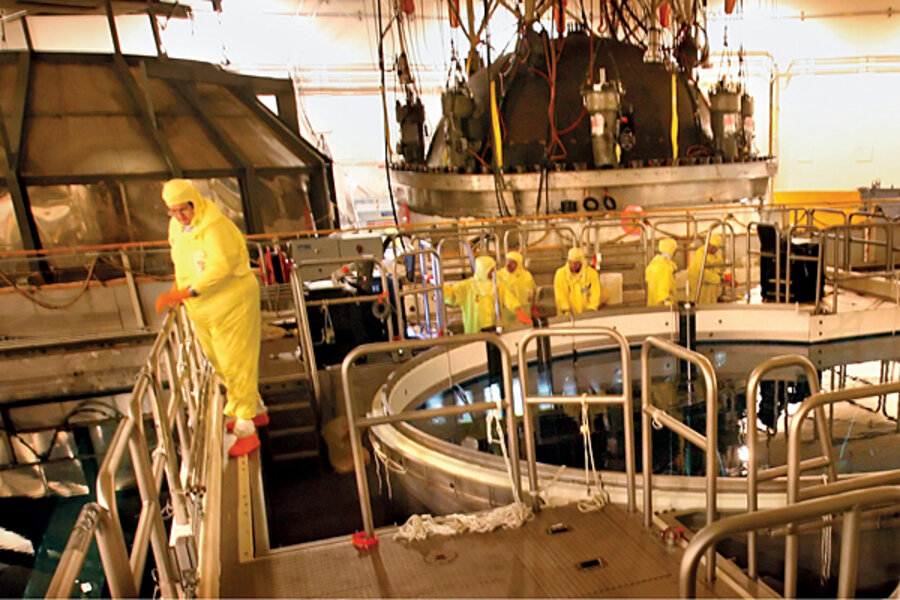The nuclear waste problem: Where to put it?
Loading...
President Obama's new Blue Ribbon Commission on America's Nuclear Future has a mission that nobody else has been able to do: Find a long-term storage solution for America's growing mountain of radioactive nuclear waste.
Earlier this month, Steven Chu, secretary of the US Department of Energy (DOE), filed papers to finally end the agency's nearly 30-year quest to make Nevada's Yucca Mountain the main US repository for spent nuclear fuel and other radioactive waste. That leaves the United States without a permanent storage site.
The commission is charged with recommending safe, long-term options for storage, processing, and disposal of civilian and military spent nuclear fuel from power plants and high-level radioactive waste. The focus is on finding an alternative to Yucca Mountain, which would have stored 70,000 metric tons of nuclear waste.
Why was Yucca Mountain shelved?
Fissures in Yucca Mountain could fill with water and submerge the radioactive waste if the climate shifts in the future, Dr. Chu told a Senate appropriations committee earlier this month. Salt domes, whose geology hasn't changed in millions of years, might make better storage, he said. Others point to the influence of Obama ally Sen. Harry Reid (D) of Nevada, who opposes the Yucca site.
Although the DOE has applied to withdraw Yucca's site license application from Nuclear Regulatory Commission consideration "with prejudice," a term meaning it never expects to refile, industry groups say they may sue to block that decision.
Why is a long-term solution important now?
With Yucca Mountain out of the picture and the Obama administration pushing for an expansion of nuclear power, another long-term storage option is needed. Currently, interim storage occurs in spent-fuel pools and in dry, above-ground casks at reactor sites.
Utilities are required under the Nuclear Waste Management Act of 1982 to keep spent reactor fuel on-site until a permanent disposal site is developed. Since then, utilities have paid billions of dollars into a fund to deal with long-term radioactive waste, but no permanent disposal site has been developed.
Another important issue is environmental: Spent nuclear fuel, which remains dangerously radioactive for millenniums, is a problem if it gets into the open environment – even thousands of years from now.
How big is the US high-level radioactive waste problem?
More than 75,000 metric tons of spent nuclear fuel are stacked up at 122 temporary sites in 39 states, according to DOE reports. America's 104 commercial nuclear reactors produce about 2,000 metric tons of spent nuclear fuel each year. If all existing reactors were to be relicensed for 60 years, they would produce about 130,000 metric tons of spent nuclear fuel over that time, the DOE reported in 2008. Any new nuclear reactors would require additional long-term storage.
What technologies might the commission evaluate?
1. Reprocessing spent uranium reactor fuel.
Some argue that reprocessing would reduce waste by separating out plutonium that could then be packaged as "mixed oxide," or MOX, fuel and used in reactors in place of low-enriched uranium. It's not clear whether the amount of high-level waste would be reduced much, unless some other technology is used in conjunction with it. France uses reprocessed MOX fuel to power its nuclear plants, but MOX remains a proliferation threat because the plutonium in it could be used in a nuclear bomb. Reprocessing also requires having a lot of plutonium. In 2008, France reported a stockpile of 55 metric tons of separated plutonium from commercial reactors, enough for roughly 6,000 bombs, according to Frank von Hippel, a nuclear physicist and nonproliferation expert at Princeton University in New Jersey. The technology is also costly: A reprocessing plant might cost $40 billion or more.
Reprocessing, combined with a fleet of fast reactors (see No. 2 below), could in theory burn up long-lived radioactive elements that make spent fuel difficult to site and costly to store. But nonproliferation experts are doubtful. "No potential reprocessing option that would reduce the proliferation risk has yet been identified," says Edwin Lyman, a physicist and proliferation expert with the Union of Concerned Scientists in Washington.
2. Fast neutron reactors.
Advantages include their ability to use up, or "burn," plutonium and other undesirable, long-lived radioactive elements, potentially reducing the space needed for longer-term storage. Disadvantages include high cost, complexity, extended shutdowns, and use of plutonium-based fuel that's vulnerable to theft and proliferation. A few fast reactors were built and tested in the US, but the technology was not pursued because of cost, reliability concerns, and proliferation issues.
3. Traveling wave reactors.
A TWR "initially contains only a small igniter of fissile fuel, which is used to kick off the chain reaction," explains a publication from TerraPower, which is working to develop TWRs. "The wave of fission would move slowly through the core, splitting many more of the fuel atoms than a conventional reactor." In theory, it could use spent fuel from conventional reactors, or draw on stocks of depleted uranium. This would reduce the volume of spent fuel and waste, thereby also reducing the risk of proliferation.
4. Deep geological disposal.
Searching for a site to replace Yucca Mountain is not the commission's job, but the group is asked to propose a process for selecting one.
When will the commission make its recommendations?
The first recommendations of the panel – co-chaired by former Indiana Congressman Lee Hamilton and Brent Scowcroft, a former national security adviser – are due in 18 months, with the final report set for release in 2012.





